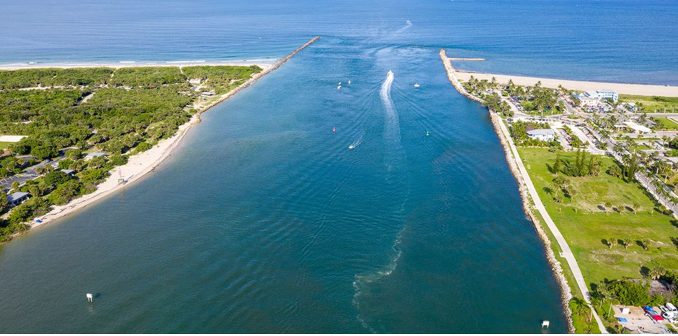This is Boating 101, but it never hurts to have a refresher. Here’s some good basic advice about how to run an inlet from America’s Boating Club:
Navigating an inlet can be tricky and dangerous, so you should know how to safely run an inlet before you encounter one.
Prepare for the approach. Before you make an approach, study the wind and tide, and eyeball the chart. Go out to the sea buoy before shooting the inlet. The buoys’ locations were calculated to assist a direct approach.
Call the pros. If there’s a U.S. Coast Guard unit or commercial tower present, you can call them if you have any concerns about conditions. They will be glad to advise, and their knowledge is free.
Stow your gear. Secure loose gear and lines prior to your approach to prevent them from being washed overboard in rough seas. Don’t deploy fenders until you’re past the inlet in smooth water. Examine your filters and water separators, which should be clean and clear. Inlet turbulence can mix dirt and debris into your fuel.
Be a traffic cop. If visibility is poor or you’re concerned about oncoming traffic, broadcast a “sécurite” call on channels 16 and 13. As you begin your approach, don’t be so focused that you’re not aware of nearby traffic. Look around.
Know the set of wind and current. In cross seas, apply just enough power to overcome the effect of the seas and maintain your course; then, in quarter seas, take them somewhat aft of the bow. While it can appear as if your bow is pointing upwind and up sea from the inlet’s entrance, the boat’s track—your actual course—should be in the center of the channel.
Often, you’ll lose the effect of the quartering wind and seas just as you enter the protected water between the jetties. At that point, be careful not to overshoot. Be prepared to back off the throttles and gently swing onto a direct course.
Assess wave heights. Remember that waves can appear smaller than they really are. Stand off until you can gauge their size. If the seas look particularly boisterous and you’re concerned, check the tide again. An ebb bucking on the onshore breeze will create more of a chop. It could be best to wait for the change of tide when conditions will likely calm down.
Ride the waves. During your approach, throttle back and come in on the backs of the waves, letting them pass under you. If you are aboard a fast, deep-V hull, you can apply enough power to ride the back side in. Don’t allow the boat to top the crest or ride down the swell; that’s an invitation to stuff the bow. Read more:




